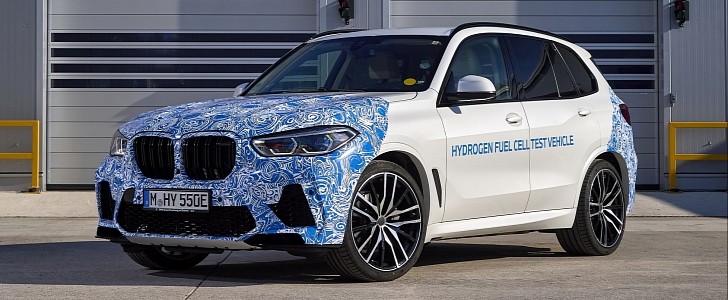With electric vehicles becoming the new norm for the automotive industry, carmakers are exploring multiple ways to generate electricity, one of which is using hydrogen fuel cell technology. You still end up with an EV, albeit one that doesn’t have a long “charging” time, as you can refill its hydrogen tank in just a few minutes.
BMW likes this idea and they’ve already begun public road testing for the so-called i Hydrogen NEXT prototype, which is based on the X5 SUV. The goal is to have a production model up and ready come next year, serving as a long-term alternative to internal combustion engines, plug-in hybrid systems and even battery-electric drivetrains.
According to BMW AG board member Frank Weber, hydrogen fuel technology is an attractive option for sustainable drivetrains, especially in “larger vehicle classes,” which is why this prototype is an X5 and not something more compact.
The BMW i Hydrogen NEXT uses fuel cells developed by Toyota, while the fuel cell stack and the drive system are made by the German brand. The electrical output being generated is 168 hp (170 ps), while energy stored in a performance buffer battery can be used for short bursts. As a result, you end up with a max output of 369 hp (374 ps), which happens to correspond to what you get with BMW’s most powerful inline-six gasoline engine.
Meanwhile, the hydrogen that supplies the fuel cell is stored in two 700-bar tanks made from carbon-fiber-reinforced plastic (CFRP). The tanks hold a total of six kg (13.2 lbs) of hydrogen and the precisely controlled reaction with oxygen in the fuel cell is what generates the electricity – the drivetrain ultimately emits just water vapor.
Another thing the carmaker will be testing out is the software that controls all the driving and operating functions, which is why the i Hydrogen NEXT will be driven for thousands of miles in real traffic situations before production can be green-lit.
According to BMW AG board member Frank Weber, hydrogen fuel technology is an attractive option for sustainable drivetrains, especially in “larger vehicle classes,” which is why this prototype is an X5 and not something more compact.
The BMW i Hydrogen NEXT uses fuel cells developed by Toyota, while the fuel cell stack and the drive system are made by the German brand. The electrical output being generated is 168 hp (170 ps), while energy stored in a performance buffer battery can be used for short bursts. As a result, you end up with a max output of 369 hp (374 ps), which happens to correspond to what you get with BMW’s most powerful inline-six gasoline engine.
Meanwhile, the hydrogen that supplies the fuel cell is stored in two 700-bar tanks made from carbon-fiber-reinforced plastic (CFRP). The tanks hold a total of six kg (13.2 lbs) of hydrogen and the precisely controlled reaction with oxygen in the fuel cell is what generates the electricity – the drivetrain ultimately emits just water vapor.
Another thing the carmaker will be testing out is the software that controls all the driving and operating functions, which is why the i Hydrogen NEXT will be driven for thousands of miles in real traffic situations before production can be green-lit.






















